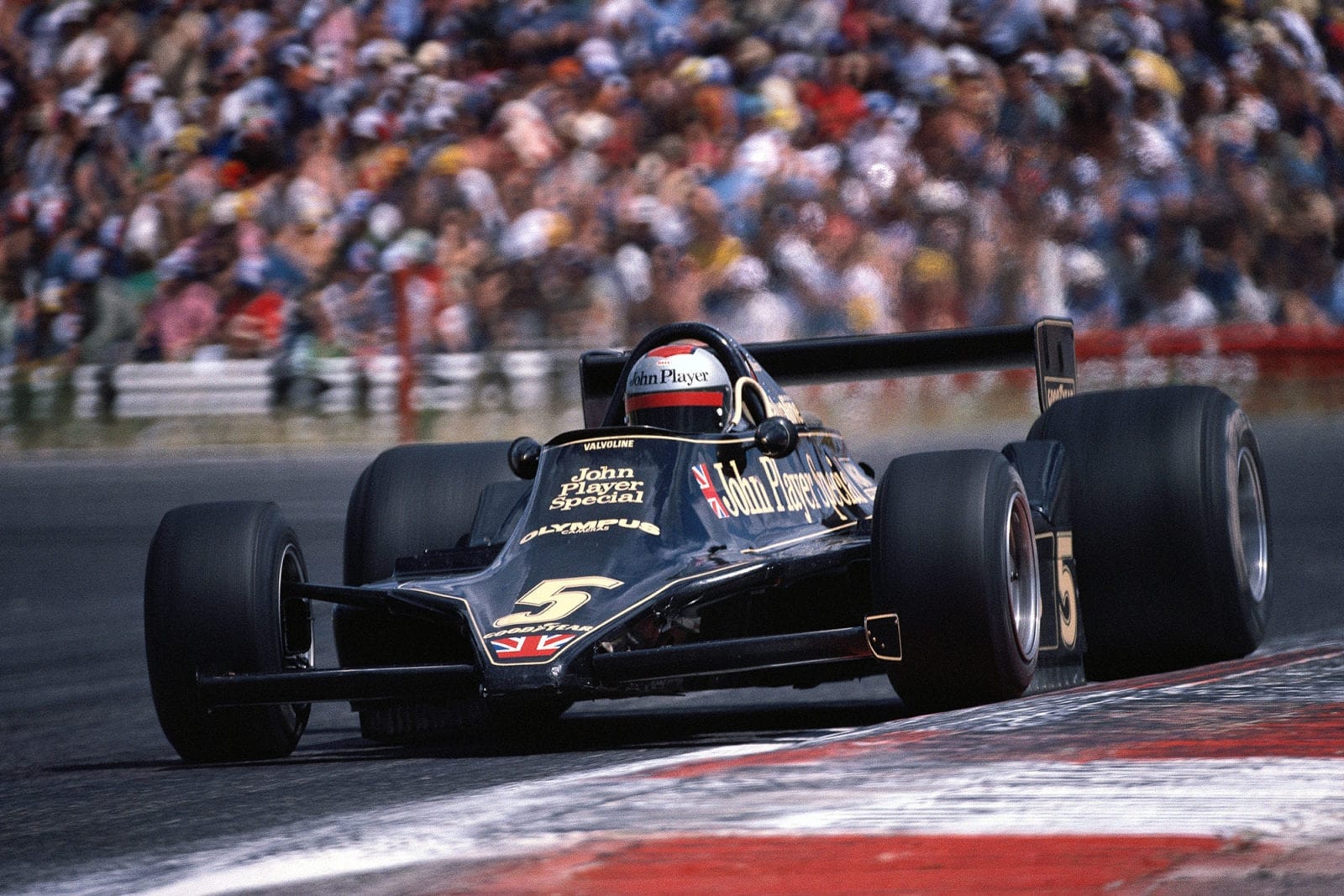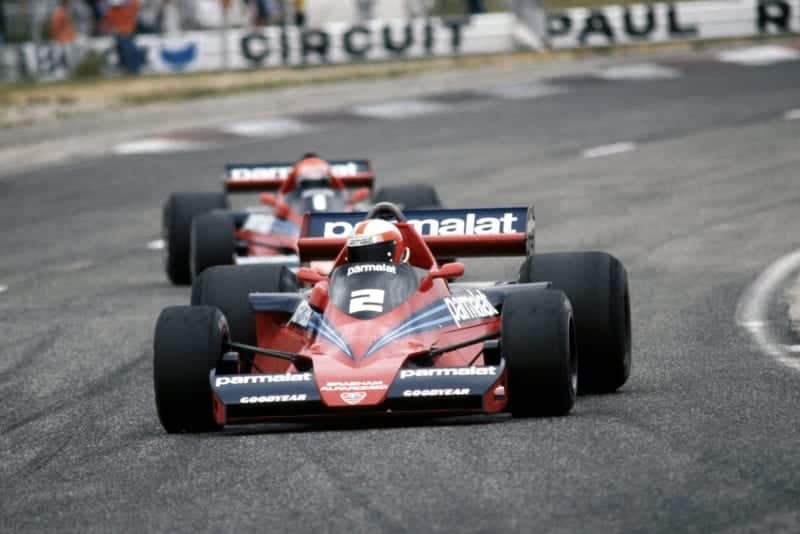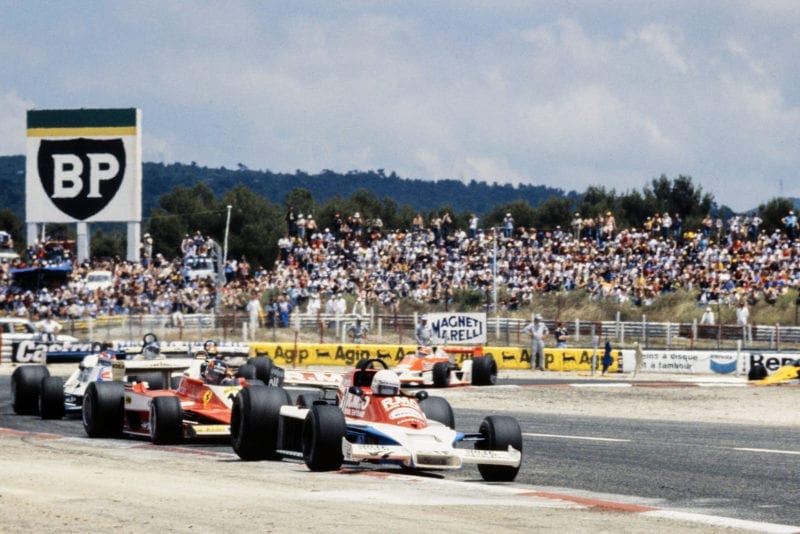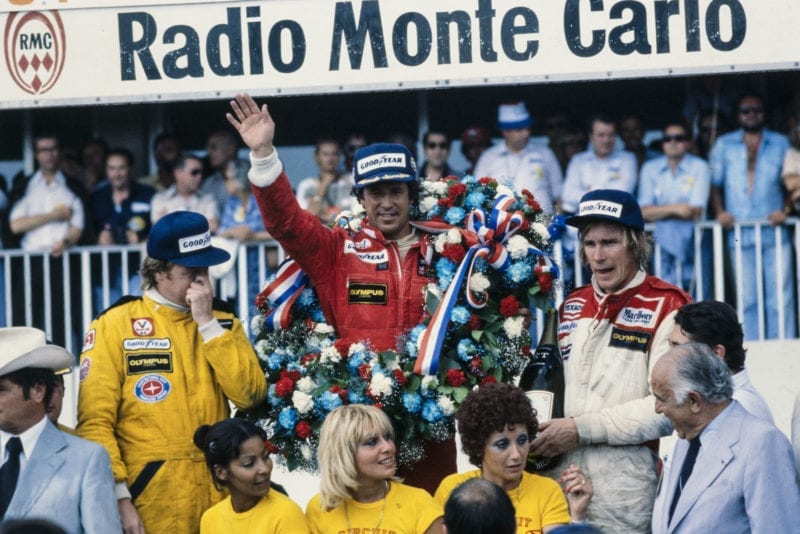1978 French Grand Prix race report

Mario Andretti took his fourth win of the season at the French Grand Prix
Motorsport Images
Lotus still ahead
Paul Ricard, July 2nd
Following two weeks after the Swedish G P, the immediate topic o f interest at the flat and featureless Paul Ricard autodrome was the matter of the cooling extractor fans on the Brabham-Alfa Romeos. Instant action was taken by the Formula One Constructors’ Association and the C SI and the outcome was that they were declared to be illegal, but the results of the Swedish race were to stand. In consequence the Brabham team appeared in France with the same two cars, Lauda (BT46/6) and Watson (BT46/4) without the fans and all the cowling and back in the form in which they raced before Sweden, with front-mounted water radiators. The rest of the entry was more or less as seen previously, with numerous small modifications to some of the cars, described elsewhere in this issue.
Qualifying
With the circuit being long enough to accommodate everyone for practice there was no need for any pre-practice seeding o f the “ rabbits” and all 29 drivers were ready for the Friday morning practice session from 10 a.m. to 11.3 0 a.m. The Ensign team had replaced Ickx with the Irishman Daly, the Finn Rosberg was still number two in the A T S team, and Giacomelli was driving the third works McLaren. The morning was hazy and ominously still, with almost total cloud cover as practice began, not at all the travel agent’s idea o f the South of France, but nonetheless ideal for fast motoring, providing it remained stable. The circuit had not been used for Formula One since 1976, when Hunt set the fastest practice lap in 1 min. 47.89 sec. with a M cLaren M 23, and fastest ever was Lauda (Ferrari T 2) in 1975 at 1 min. 47.82 sec.; of little interest in view o f three years’ progress. The official lap record was set up during the 1975 French G P by Jochen Mass in a M cLaren M 23 at 1 min. 50.60 sec. The vastness o f the pit area at Paul Ricard, and the comic, circus-like layout whereby half the field come into their pits under a bridge, while the other half are passing over the bridge on their way out of their pit area, makes the whole scene very remote and detached. Add to this the fact that the track itself and the signalling wall are so far from the pits that they could be on another circuit, and it is easy to see why practice at Paul Ricard is all a bit detached and characterless. The morning had not really got under way before a sprinkling of raindrops came down, and that was it, the cars were covered up and everyone disappeared, and at that point Lauda was holding fastest time with 1 min. 45-52 sec., but in truth the scene had not really got under way properly. The rain spots did not develop so everyone re-appeared and got on with practice, though there were damp patches on the circuit, which prevented any all-out 100% laps, so no-one approached Lauda’s time. Andretti had an almighty spin when he hit one of these damp patches, which bounced the Lotus 79 over a kerb and up into the air, to land on its nose, all at 130- 140 m.p.h. The nose of the car was crumpled and the forward part of the monocoque was distorted, but during the lunch-hour the Lotus lads hammered it reasonably straight and reset the front suspension as best they could, but there was no way of removing the crease in the aluminium panel over the front of the cockpit.
The afternoon session was a bit better and lots of drivers got down to Lauda’s morning time, while Watson went better than them all with an all-time best of 1 min. 44.41 sec. The Alfa Romeos were proving very fast, extractor fan or no extractor fan, but Andretti was only fivehundredths of a second away from Watson, in spite of the bent monocoque. Rather than make a backward step and use one of the obsolete Lotus 78 cars, Andretti preferred to stick with the Lotus 79 even though some of the adjustments were at their limits to align the wheels and suspension. Watson and Andretti were in an elite class of their own, in the 1 min. 44 sec. bracket, and then came Lauda, Tambay, Peterson, Scheckter, Hunt, Reutemann, Villeneuve, Laffite and Jabouille all in the 1 min. 45 sec. bracket, with some of them capable of going faster still and others not. After these drivers the times became a bit academic, while there was more than six seconds between the fastest and the slowest. The Alfa Romeos were clocking 286 k.p.h. (177.7 m.p.h.) down the back straight, while Tambay’s McLaren was only doing 275 k.p.h. (170.9 m.p.h.) and the Ligier was doing 270 k.p.h. (167.8 m.p.h.). During the afternoon there were a remarkable number of cars spinning off at corners, but the Paul Ricard circuit is so vast and forgiving that sloppy driving is encouraged, rather than penalised.

John Watson set the fastest time to put Brabham on pole
Motorsport Images
Somehow practice did not seem to have the urgency that is normal for a Grand Prix, and Saturday morning being grey and cool did nothing to help. During the untimed test session of 11/2 – hours on Saturday morning there was rain in the air and there was very little apparent excitement to herald the final hour of qualifying in the afternoon. During the lunch hour hordes of amateur racers were let loose on the circuit in Renault R5 saloons and they wrecked part of the barriers, so there was a 30-minute delay to the Formula One practice, while repairs were carried out. Everyone had been strapped into their cars and all warmed up and ready to go at 1 p.m. when the delay was announced. Naturally everyone unwound, got out of their cars and stood around not knowing what to do, so that when the final practice eventually got under way it crept into action, rather than the more usual full-blooded charge. Lauda was quickly into the 1 min. 44 sec. bracket, followed soon after by Peterson and Hunt, while Andretti was still juggling with his variables, especially tyres. There were a lot of “ sticky” Goodyear tyres about, almost of a sponge rubber texture and some cars were tearing them to bits in one lap, a mere 31/2 miles! Goodyear had moved in with operation “ overkill” to ensure that Michelin were totally humiliated on their home ground, and the operation was completely successful. The two Ferrari drivers and the Renault were never in the picture, and Goodyear felt they had repaid the blow they received when Michelin won the United States GP (West) at Long Beach. That victory by the French tyre firm did not go down at all well with the Goodyear hierarchy.
Lauda held on to the fastest lap for the afternoon, but Watson still held the overall fastest lap and pole position, from his time of the day before. Hunt was in great form with the now old-fashioned McLaren M26, while Peterson was really getting into the groove, and things were beginning to “ come good” for Andretti. At last practice seemed to be reaching its normal tempo, and with fifteen minutes to go there was a feeling of a lot of teams being wound up tight for a lastminute do-or-die effort. Then it rained, and practice fizzled out like a damp squib. If the Renault R5 saloons hadn’t caused the 30-minute delay the whole front end of the starting grid might have looked very different. As it was the front row was held by Watson and Andretti, with all the usual top runners with them in the front half. A total of 26 cars was being taken for the race, so this meant three non-qualifiers and these were Merzario, Derek Daly with the Ensign and Rebaque with his brown Lotus 78 car. Rene Arnoux had quietly got the lone Martini M K23 well into the grid, Stommelen was not in the same class as his young Italian team-mate Patrese, in the golden Arrows, while Giacomelli was still feeling his way along in the third McLaren works car. The ATS cars filled the back row of the grid, Rosberg scraping in by twohundredths of a second, driving the newly completed spare ATS, having abandoned his original car on Friday morning.
For a change the sun appeared on Sunday morning and it was more like the South of France as a record crowd thronged onto the dusty plain on which the Autodrome is built. During the 30-minute test-period before lunch all manner of troubles arose. The Copersucar team had fitted a rebuilt engine into the Fittipaldi F5A/2 overnight, and now it refused to run properly, so rather than waste time in a fruitless search for something that might not be found, a change back to a known engine was made in record time. At the other end of the pits Villeneuve tried the spare Ferrari, number 035, and found it much better to handle than 034, which he had used throughout practice so decided to use it in the race. The Williams 002 broke bottom gear in its Hewland gearbox, so Alan Jones changed over to the spare car 001 and the Shadow mechanics were vainly trying to trace a misfire in Regazzoni’s engine. Tambay had problems with his gearbox, but they were soon sorted out. The Renault team had prepared R S01/0 2 with a new engine for Jabouille, and the second car was being rigged up with a camera on the nose for a publicity “ circus act”.
Race

Rene Arnoux (Martini) mixes with Ferraris and McLarens on his 3rd ever grand prix start
Motorsport Images
After interminable small-saloon car races for “ Mickey Mouse” championships and a vast parade of Renault cars to illustrate their involvement in the sport, with the Le Manswinning Renault driven by Jean-Pierre Jaussaud bringing up the rear, the time approached for the serious business of the French GP over 54 laps of the flat autodrome. As the 26 cars left the pit area to do a lap round to the grid the spare Renault, with its camera on the nose, joined in driven by Jackie Stewart. As the competitors took their places on the grid Stewart positioned the Renault R S01/03 at the head of the field for the most incredible “ circus-act” promulgated by the E L F cinema division. Half-way down the grid the Renault mechanics were looking mournfully at the smoke issuing from the exhaust pipe of Jabouille’s car, while their spare car in full health was unobtainable at the front of the field with the wee Scot strapped in the cockpit. Having said he would never drive a single-seater racing car again, Stewart was not only in the Formula One Renault but sitting on the grid with 26 eager racing drivers behind him. Stewart led the field away on the pace-lap and we just hoped the camera didn’t fall o ff at this crucial juncture o f the 1978 French (comic) Grand Prix, especially remembering Stewart’s loud words at the Nurburgring when a camera fell off a Porsche and put Graham Hill’s BRM into the bushes; but serious safety neurosis is only skin deep where money and publicity are concerned. Unkind people were saying it was the only way Renault could ever get a picture of their car leading a Grand Prix field. The Renault racing team were saying nothing, just looking anxiously at the smoke issuing from 02.
Everyone arrived back on the grid safely, Stewart made himself scarce and all eyes were on the red light, especially those o f Watson and Peterson, remembering recent starts. The green light shone and the start was a superb one, with the Alfa Romeo and the Lotus on the front row matching each other on acceleration. Watson had the advantage going into the first corner and Hunt tried to follow him through, but Andretti opped him o ff and so did some others. Watson still led out onto the long back straight, but the black Lotus was right behind and before they reached the end Andretti pulled the 79 out o f the slipstream and went by into the lead. By the end of the opening lap it was all over. Andretti and the Lotus 79 pulled away into a firm lead, looking completely calm and smooth. After his good start Hunt was down in sixth place, with Peterson fifth, Lauda fourth and Tambay third, Watson still in second place. The Renault quietly expired with a broken engine, amid a lot of red faces, and Regazzoni was in the pits with his engine still misfiring. On lap 3 Lauda took third place from Tambay, and on lap 5 Peterson moved the young Frenchman down another place, so we now had Lotus 79 leading and pulling away, then the two Brabham-Alfas and then the second Lotus 79, with no-one else in the game for the lead. Alan Jones was driving hard, as he always does, and was holding on to the two works McLarens, safely ahead of Scheckter’s Wolf and Laffite’s Ligier JS9 and Patrese’s Arrows.
Peterson was clearly not content to be in fourth place, especially with two Brabham-Alfas between him and his team-leader and he soon pressured his way past Watson and set his sights on the back of Lauda’s car, but he didn’t have to make much effort. On lap 9 there were wisps of smoke from the Alfa’s exhaust pipes on the left side and on the next lap Lauda slowed dramatically and limped round to the pits, the engine sounding very rough and not on 12 cylinders. A quick look in the left-hand air-inlet box was sufficient; there were bits of valves, guides and other nastiness to show that the Alfa Romeo engine had destroyed itself. The Cheshire-cat grins in the Lotus pit were fully justified as the two beautiful, efficient, sleek black Lotus 79 cars had it all wrapped up in first and second places, and only ten laps of the race run.

Andretti and Peterson soon moved into a Lotus 1-2
Motorsport Images
It may have been all over as far as Team Lotus and a lot of people were concerned, but there was one man to whom the race was anything but over; that was James Hunt. As the Brabham mechanics were looking at Lauda’s broken engine Tambay arrived at the McLaren pits with his left rear tyre deflated. By the time it was changed and he rejoined the race poor Tambay was down in nineteenth place, while Hunt inherited his fourth place. Almost unnoticed at this point Depailler retired with a broken engine in his Tyrrell, and Villeneuve stopped for a change of Michelin tyres. Reutemann had already been in and changed his and it was unbelievable to see the two Ferraris running last and next to last. Before their stops they had been an unspectacular thirteenth and fourteenth, at the back of the mid-field runners; now they were not even in sight of the “ rabbits” . Still smarting from having been “ carved-up” on the opening lap (like Andretti was at Zandvoort last year!) Hunt was now giving it all he’d got and closing on Watson’s Brabham quite quickly. By lap 16 he was past the Ulsterman without any trouble and pulling away, though not closing on the two Lotus cars in the same way. Meanwhile, his young French team-mate was picking up places in a most impressive manner, his smooth style being very suited to the geometric curves of the French Autodrome.
In fifth place was Alan Jones with the Williams, flying the Saudia Airlines colours well, and fending off attacks from Scheckter and Laffite. When Hunt got past Watson it put renewed vigour into Jones and he drew away from the Wolf and the Ligier and began to attack the Brabham, fourth place being well worth fighting for. While the two Lotus cars had command of the race, with Peterson closing up relentlessly on Andretti, Hunt was hanging on to them in a spirited and heroic drive, shutting the mouths of those who have been “ rubbishing” him recently. The battle between Watson and Jones had reached stale-mate, as had that between Scheckter and Laffite, while Peterson was now right up behind his team-leader. The way the “ seventy-nines” sat on the road made you cheer or cry, depending whose side you were on.
At half-distance, which was 27 laps, Andretti led Peterson by a few lengths, Hunt was still in a fighting third place, Watson was a tenuous fourth with Jones right behind him in fifth place. In sixth and seventh and equally close, were Scheckter and Laffite, then came Patrese all alone in eighth place, Pironi ninth, Fittipaldi tenth and Tambay already up to n th place, having just disposed of Stuck’s Shadow. Jochen Mass was leading the rest, in the order Lunger, Keegan, Arnoux, Stommelen, Brambilla and Giacomelli. The two Italians had been higher up but the Surtees driver had a big spin and nearly collected his team-mate (oh happy John!) while the works McLaren lad had gone straight on at the chicane at the western end of the circuit. Lapped by the leaders were Rosberg, who had made a pit stop, and the two unhappy Ferrari drivers. Giacomelli disappeared on lap 29 when his engine blew up and Reutemann stopped for another change of tyres, but Michelin had lost their way and a set of Kleber-Colombe would have been as good. Villeneuve had made a second change of tyres and rejoined the race just behind the Watson/Jones dice, though a lap behind, he then proceeded to stay with them, at times looking as if he’d like to overtake, and with the red car fizzing about behind him Jones found his concentration being distracted just when he was ready to attack Watson. This was most unfortunate for it really looked as though “ Jonesy-boy” was capable of taking fourth place from the Brabham.
After a slight relaxation in the middle part of the race Hunt renewed his efforts and though he never got close enough to challenge Peterson’s second place, the Swede was very conscious that the red and white McLaren was just behind him. For a few laps the first three cars were equally spaced and in sight of each other, but then Andretti began to pull away slightly, but Peterson still had Hunt large in his mirrors, even though he wasn’t looking in them, preferring to judge things from his pit signals. In mid-field Fittipaldi was going very well, having caught and passed Pironi’s Tyrrell and now he was attacking Patrese’s Arrows and disposed of him with ease, the yellow Brazilian car for once pleasing its driver and encouraging him to have a bit of a go. Alas, it was pride before a fall, for on lap 44 a nut came undone on the left-hand rear lower suspension member and the wheel collapsed inwards, leaving the Brazilian stranded out on the circuit. While Hunt was trying to worry Peterson into making a mistake, Laffite was really giving Scheckter a rough time for the end of the race was in sight. Every time the Ligier made a move the Wolf parried it and this went on right to the end, the two cars actually starting their last lap side-by-side, sitting it out into the first corner, but the Wolf won, and they finished the last lap wheel-to-wheel with the French crowd urging the blue car on, but the dark blue and gold Wolf had it by mere inches. Meanwhile the leading trio had started their last lap equally spaced, but the two black cars finished on their own. Hunt had lost concentration on that last lap when he felt sick, and had spun, but he gathered it up and finished a safe third. At the end of the leader’s lap Tambay had kept going hard right to the end and had caught and passed Pironi with three laps to go and with a few more might have caught Patrese. His ninth place did not do justice to his driving.
Of the tail-enders Keegan retired almost unnoticed out on the circuit with a broken engine, and Lunger retired right opposite the pits with a similar Cosworth complaint after a good drive which had got him up into thirteenth place.
With five laps to go Reutemann made a third stop to try yet another type of Michelin tyre and was then credited with a new lap record; small compensation for a miserable weekend.

Andretti celebrates his win
Motorsport Images
So, for the third time this year Team Lotus scored a double, the Lotus 79 scored its third victory and as Colin Chapman said, “ What a super pair of drivers, what a super car, what a super team, but we haven’t finished yet.” Who was it who said Team Lotus were finished a year or two ago? Not me, I merely said I had become tired of waiting for Mario Andretti to show the promise everyone talked about, and thought he’d missed the boat. I was completely wrong, I’m happy to say, and so were those people who said Team Lotus were finished in the dark days of 19 75. – D.S.J.
